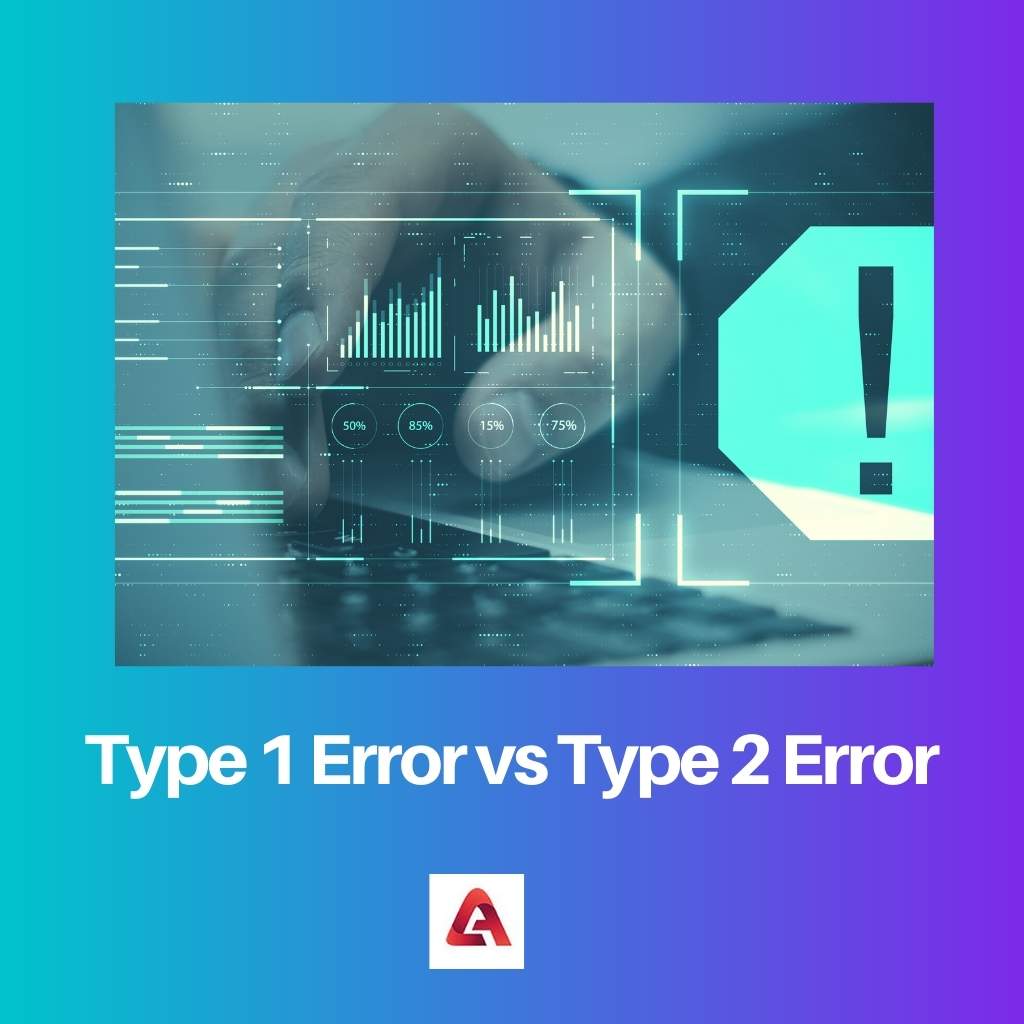When a researcher rejects a null hypothesis that is actually true and accepts a null hypothesis that is actually false, Type 1 and Type 2 mistakes occur.
There are four situations that are likely to arise during the acceptance or rejection of a null hypothesis. Among these four possible situations, two are correct. The other two lead to incorrect results and are known as errors in statistics.
Key Takeaways
- Type 1 error occurs when a true null hypothesis is rejected, leading to a false positive result.
- Type 2 error arises when a false null hypothesis is not rejected, causing a false negative outcome.
- Researchers aim to minimize errors by adjusting significance levels, sample sizes, and study designs.
Type 1 Error vs Type 2 Error
The difference between type 1 and type 2 errors is that type 1 mistake happens when a researcher rejects the null hypothesis when it is true actuality. In contrast to that, type 2 error occurs when a researcher takes the wrong decision of accepting a null hypothesis because it is wrong in reality. The rate of error that can take place in type 1 is denoted by alpha. The rate of error that can take place in type 2 is denoted by beta.

Rejection of reality and acceptance of false reality by a researcher is a type 1 error. One common reason for making type 1 errors is improper research and sample size. It is also called the error of the first kind.
Acceptation of false reality and rejection of reality by a researcher is a type 2 error. This error is likely to occur when the sample size is not determined appropriately. The rate of this error is denoted by beta (a Greek letter).
Comparison Table
| Parameters of Comparison | Type 1 Error | Type 2 Error |
|---|---|---|
| Decision | There is a rejection of reality by the researcher. | There is acceptance of reality by the researcher. |
| Reality | The situation is always true in this case. | The situation is false in this case. |
| Also Called | The error of the first kind. | The error of the second kind. |
| Occurrence | The probability of occurrence is alpha. | The probability of occurrence is beta. |
| Reducing method | Decrease the alpha. | Increase the beta. |
What is Type 1 Error?
A null hypothesis is rejected by a researcher in a type 1 error, yet it is true in fact. Research involving a certain population is done so as to find out whether a null hypothesis is true or false.
Many times this research involving a certain test can be interpreted wrongly, and this is when errors occur.
One of these types of errors is called the type 1 error. In type 1 error, the null hypothesis is actually true in reality, but the researcher tends to reject it.
This error is referred to as alpha error as the probability of occurrence of this error is denoted or represented by a Greek symbol alpha.
So, if the researcher takes a correct decision regarding the null hypothesis after its testing, then its probability comes to 1 minus alpha.
In simple words, it can be said as the probability of non-occurrence of type 1 error is 1 minus the probability of its occurrence (alpha).
Let’s take an example of a type 1 error; a student does not go to the canteen because he thinks it is closed. He ends up on this decision after some research from his friends, but in reality, the canteen is open.
In this situation, the boy is making a decision to reject the null hypothesis, which is actually true in reality. In terms of statistics, this is recognized as a type 1 error.
What is Type 2 Error?
In a type 2 mistake, a researcher commits the mistake of accepting a null hypothesis. In this scenario, the researcher accepts the null hypothesis once the investigation is completed, although it is untrue in reality.
The probability of occurrence of this error is considered to be represented by the Greek symbol beta. Hence, this error is also called a beta error.
The probability of not committing this error (type 2 error) is 1 minus the probability of occurrence (beta). This one minus beta is the case when the researcher is taking the correct decision, which is the rejection of the hypothesis.
It is addressed as a power of a test. It can be said as the probability of not committing a type 2 error.
In order to lower the type 2 test occurrence, one should increase the power of a test. This can be done conveniently by increasing the sample size.
Let’s take an example of a type 2 error; a student does go to the canteen because he thinks it is open. He ends up on this decision after some research from his friends, but in reality, the canteen is closed.
In this situation, the boy is making a decision to accept the null hypothesis, which is actually false in reality. In terms of statistics, this is addressed as a type 2 error.
Main Differences Between Type 1 and Type 2 Error
- There is a rejection of reality by the researcher in the type one error, whereas the researcher accepts the false reality in the type two error.
- In type 1 error, the null hypothesis, in reality, is true, whereas in type 2 error, the null hypothesis, in reality, is false.
- The probability of type 1 error taking place is alpha, whereas that of type 2 error is beta.
- Many refer to type 1 error as an error of the first kind and type 2 error as an error of the second kind.
- Type 2 error can be reduced to a certain extent by decreasing the level of alpha, whereas type 2 error can be reduced by increasing the alpha level.





